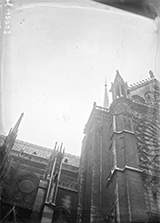by Marika Maymard
Juggler, conjurer and tightrope walker, Philippe Petit grew up nurturing the crazy idea of walking up in the sky, alone among the clouds and defying the wind, which would not be his friend. “I’m passionate about the high wire. I’m hungry to put on a show, for the theatre, for composition, arrogance, freedom. One day I will stand up and face the world, high up, alone, free and strong”. Fascinated by cathedrals, a majestic link between humanity and eternity, the Parisian chose no less a place than Notre-Dame to become a fully-fledged tightrope walker!
The year he turned 21, he wrote: “The cathedral is in my way yet again. The power of its façade, when I stop in front of its Last Judgement portal, forces my gaze to climb slowly up. At the top, the extraordinary balance of the wall of stone, which splits to let the clouds pass, reduces my confidence. From the ground, I unwittingly measure myself against the front of the building; I must resume my journey or decide to visit immediately. I pass”.
“Notre Dame, the most important monument in France, the symbol of Paris, the mysterious cathedral... This is a royal venue for my tightrope show.”
Jean-Louis Blondeau1
He recalls that it would take him a year before secretly setting up a cable between the two towers of Paris’s Notre-Dame Cathedral, at night, with the help of his friends Pablo, Jean-François and Jean-Louis (the photographer). He set off at 10 am on 26 June 1971, from the south tower, numb with cold, battling with the wind, preoccupied by balancing the cable, which could not be secured and was moving dangerously.
Finally, he walked forward, lay down on the wire, then stood up, far above the city: “Balance is voluptuous. Notre-Dame belongs to me. Paris belongs to me, the immense sky belongs to me, I forget to breathe”.
With his reputation as a tightrope walker now assured, he put on more shows. With or without official authorisation, he walked successfully at Sydney’s Harbour Bridge in 1973, between the twin towers of the World Trade Center in New York in 1974, between the towers of the Palais de Chaillot in 1984, and from the Trocadero to the Eiffel Tower in 1989, to name but a few.
He remembers this exhilarating quest for summits in several books and on screen, notably in the documentary Man on a Wire, which won several awards and trophies.
But at every stage of his career and success, memories of the young acrobat who had performed in Beaubourg’s Parvis square are invoked. Just as he had made a fan of cards appear at the top of Notre-Dame’s south tower, on the edge of the void in 1971, at the Oscars ceremony in 2009, the year of his sixtieth birthday, he juggled with the statuette he had just solemnly received, turning it upside down and balancing it on his chin.
Since his “coronation” at Notre-Dame, one of New York’s most Parisian Parisians has lived in the tower of one of the last cathedrals to be under construction: Saint John the Divine.
![]() See the report by Jean-Louis Blondeau on Philippe Petit’s walk in full
See the report by Jean-Louis Blondeau on Philippe Petit’s walk in full
1. Philippe Petit, Trois coups, Paris, Éditions Herscher, 1983. Quotes from pages 14 and 33.





